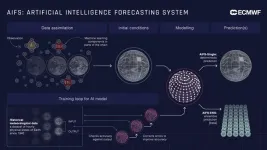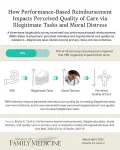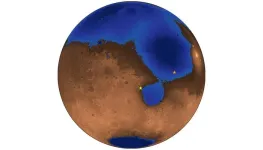(Press-News.org) Embargo: 25 February 2025 00.01 AM GMT
ECMWF – Europe’s leading centre for weather prediction makes forecast data from AI model available to all
A newly operational model, known as the Artificial Intelligence Forecasting System (AIFS), has been launched by the European Centre for Medium-Range Weather Forecasts (ECMWF), an intergovernmental centre and leader in numerical weather prediction. For many measures including tropical cyclone tracks, the AIFS outperforms state-of-the-art physics-based models, with gains of up to 20%. This high accuracy model complements the portfolio of ECMWF's physics-based models, advancing numerical weather prediction, and leverages the opportunities made available by machine learning (ML) and artificial intelligence (AI), such as increased speed and a reduction of approximately 1,000 times in energy use for making a forecast.
Amongst the available AI models, the AIFS provides the greatest granularity sought by its user community. On top of vital fields for users, like wind and temperature, and details on precipitation types from snow to rain, ECMWF says this new service is the first fully operational weather prediction open model using machine learning with the widest range of parameters. The AIFS has been designed holistically with all users in mind. For example, in the renewable energy sector it will help with predictions such as surface solar radiation levels or wind speeds at turbine levels so that operations can be maximised.
The availability of this operational machine learning model in conjunction with ECMWF’s other services is set to positively impact how national weather services in ECMWF’s 35 Member and Co-operating States and beyond will be able to make their predictions. Similarly, it potentially could help industries where forecasts for the medium range (days to weeks) can affect decision making, such as the energy sector for pricing forecasts, insurance, security and shipping sectors.
Dr Florence Rabier, Director-General of ECMWF, comments:
“This milestone will transform weather science and predictions. It showcases our dedication to delivering a machine learning forecasting model that pushes the boundaries of efficiency and accuracy, and it underscores our commitment to harnessing the power of machine learning for the weather forecasting community.
“At ECMWF, we have some of the world’s leading computing models for weather prediction, the world’s largest catalogue of meteorological data sets on which machine learning models are trained, and a team of experts from scientists to engineers who are driving the science and technology forward. It is credit to their hard work that we have achieved this today, making the AIFS operational producing the widest range of parameters using machine learning available to date. But it does not stop here as the roadmap for improvements of the models we have is a top priority. It is not only us who are innovating as it is important to remember that with ECMWF, 35 nations are working together to advance weather science to improve global predictions. This is to help national meteorological agencies in their work to contribute to a safe and thriving society. This will also trigger new services and products to benefit those who do not have access to meteorological capabilities, for example in developing countries.”
How does the model work?
Florence continues explaining how the model works: “Imagine 800 million observations processed on a daily basis, from more than 100 different satellite data and other streams including planes, boats, sea buoys and many other Earth-based measurement stations. These observations contain information about, for example, the Earth’s atmosphere, pressure, moisture, temperature, wind. Scientists next select around 60 million quality-controlled observations out of those daily observations which are then ingested into our Integrated Forecasting System (IFS). These then form what we call the initial conditions, the starting point of the next stage to deliver forecasts. Our set of initial conditions data as well as our historical meteorological dataset archive are widely used the world over, from big tech companies to small starts-ups to help them innovate.
“Every 6 hours, these initial conditions feed into the newly operational Artificial Intelligence Forecasting System (AIFS), where the machine learning model, using special mathematical rules, assesses how the current meteorological conditions will influence the entire weather system on the Earth for the coming days. Today, we are launching the first fully operational model of this kind based on machine learning.”
This model joins a series of other ECMWF services, one of which is the delivery of global weather forecasts by the Integrated Forecasting System (IFS), which not only provides the ability to gather the initial conditions but also produces forecasts at a world-leading resolution of 9 km over the globe. It uses physics-based capabilities to reach this, integrating the laws of physics in its computer code.
The first operational version is called AIFS-single. It runs one single forecast at a time, known as a deterministic forecast. However, ECMWF is pushing this model to create a collection of 50 different forecasts with slight variations at any given time to provide the full range of possible scenarios, which is known as ensemble modelling, a technique developed and implemented by ECMWF more than thirty years ago.
ECMWF says its roadmap for its Artificial Intelligence Forecasting System is clear, and the launch of this AIFS-single 1.0 model as an operational service is only the first step. The next step will be making ensemble forecasts available following the same path. The potential to hybridise the two approaches, data driven and physics-based, will also be a field of research over the coming years to explore this potential further.
Dr Florian Pappenberger, Director of Forecasts and Services at ECMWF, adds:
"This is a huge endeavour that ensures the models are running in a stable and reliable way. At the moment, the resolution of the AIFS is less than that of our model (IFS), which achieves 9 km resolution using a physics-based approach. We see the AIFS and IFS as complementary, and part of providing a range of products to our user community, who decide what best suits their needs.”
ECMWF's weather predictions are focused on the medium range (3 days to 15 days), sub-seasonal, and seasonal (up to a year ahead). These are critical to help national weather services plan for extreme events – the earlier it is known that an event is likely to take place, the easier it is for governments and relevant agencies to better prepare for those events.
Florian concludes:
"ECMWF's AIFS was an experimental model for some months whilst we enhanced its capabilities by interacting with our Member States and users to refine it. We have brought it to an operational state for the benefit first and foremost of our Member and Co-operating States as well as many industry sectors, such as energy. Making such a system operational means that it is openly available and has 24/7 support for our meteorological community. As always, we have to ramp up this service to full maturity, and we look forward to engaging directly with our users to ensure all needs are covered where possible."
Whilst ECMWF concentrates on predictions from days to months ahead over the whole globe, the national meteorological services also focus on forecasts that are nationally and regionally relevant, and they oversee issuing weather warnings for their country in collaboration with other agencies. This year marks 50 years since the creation of ECMWF, and the complementarity between ECMWF and the meteorological centres across its Member States is essential to have trust, excellence and resilience in services and advance science for the benefit of everyone.
ENDS
For further information please contact:
All enquiries should be directed in first instance to: pressoffice@ecmwf.int
In case you need urgent help please reach out to Lorna Campbell 0044 (0)7836 625999
Note to editors
About ECMWF
The European Centre for Medium-Range Weather Forecasts (ECMWF) is a world leader in numerical weather predictions providing high-quality data for weather forecasts and environmental monitoring. As an intergovernmental organisation, we collaborate internationally to serve our members and the wider community with global weather predictions, data and training activities that are critical to contribute to safe and thriving societies.
The success of our activities depends on the funding and partnerships of our 35 Member and Co-operating States who provide the support and direction of our work. Our talented staff together with the international scientific community, and our powerful supercomputing capabilities, are at the core of a 24/7 research and operational centre with a focus on medium- and long-range predictions. We also hold one of the largest meteorological data archives in the world, including ERA5 funded by the European Union Copernicus programme.
Our mission: Deliver global numerical weather predictions focusing on the medium-range and monitoring of the Earth system to and with our Member States.
Our vision: World-leading monitoring and predictions of the Earth System enabled by cutting-edge physical, computational and data science, resulting from a close collaboration between ECMWF and the members of the European Meteorological Infrastructure, will contribute to a safe and thriving society.
ECMWF has established a strong partnership with the European Union and has been entrusted with the implementation and operation of the Climate Change and Atmosphere Monitoring Services of the Copernicus Programme, as well as being an important contributor to the Copernicus Emergency Management Service and to the Destination Earth initiative. Other areas of work include high-performance computing and the development of digital tools that enable ECMWF’s provision of data and products covering weather, climate, air quality, fire and flood prediction and monitoring.
ECMWF is a multi-site organisation, with its headquarters in Reading, UK, a data centre in Bologna, Italy, and a large presence in Bonn, Germany, as a central location for our EU-related activities. ECMWF is internationally recognised as a voice of expertise in numerical weather predictions for forecasts and climate science.
www.ecmwf.int
About Copernicus www.copernicus.eu
About Destination Earth https://destine.ecmwf.int/
More about the AIFS operational model can be found here
END
ECMWF – Europe’s leading centre for weather prediction makes forecast data from AI model available to all
A newly operational model, known as the Artificial Intelligence Forecasting System (AIFS), has been launched by the European Centre for Medium-Range Weather Forecasts (ECMWF), an intergovernmental centre and leader in numerical weather prediction.
2025-02-25
ELSE PRESS RELEASES FROM THIS DATE:
New paper-based device boosts HIV test accuracy from dried blood samples
2025-02-24
In parts of the world where traveling to a clinic for routine blood tests is a financial and logistical challenge, HIV patients increasingly have the option to collect and ship a drop of their blood in paper-based devices that absorb the sample and store it for analysis in far-away labs.
While this technology is helpful for tracking someone’s adherence to their drug regimen or monitoring disease progression, the most frequently used devices don’t control how much blood they collect, potentially leading to inaccurate readings of a person’s infection.
Understanding this limitation, Charlie Mace, an associate professor at Tufts University’s ...
Pay-for-performance metrics must be more impactful and physician-controlled
2025-02-24
Pay-for-Performance Metrics Must Be More Impactful and Physician-Controlled
Background: This editorial builds on a study by Brulin and Teoh, released ahead of the March/April 2025 issue of Annals of Family Medicine, which found that performance-based reimbursement is associated with lower perceived quality of care by increasing illegitimate tasks and moral distress for primary care physicians.
Editorial Stance: Quality metrics and pay-for-performance initiatives are far more expensive than many patients, clinicians, or administrators realize. The authors call for more rigorous review through cluster randomized controlled trials both before and after implementation—and ...
GLP-1RAs may offer modest antidepressant effects compared to DPP4is but not SGLT-2is
2025-02-24
Follow @Annalsofim on X, Facebook, Instagram, threads, and Linkedin
Below please find summaries of new articles that will be published in the next issue of Annals of Internal Medicine. The summaries are not intended to substitute for the full articles as a source of information. This information is under strict embargo and by taking it into possession, media representatives are committing to the terms of the embargo not only on their own behalf, but also on behalf of the organization they represent.
----------------------------
1. ...
Performance-based reimbursement increases administrative burden and moral distress, lowers perceived quality of care
2025-02-24
Performance-Based Reimbursement Increases Administrative Burden and Moral Distress, Lowers Perceived Quality of Care
Background and Goal: Performance-based reimbursement (PBR) is a payment system in which clinics receive compensation based on the quality and outcomes of care they deliver, rather than the volume of services provided. Although designed to improve efficiency and effectiveness, the growth of PBR systems has been linked to increased administrative work for physicians. This study examined how PBR affects doctors' perceived ability to provide quality ...
Survey finds many Americans greatly overestimate primary care spending
2025-02-24
Survey Finds Many Americans Greatly Overestimate Primary Care Spending
Background and Goal: This study, based on an online survey of 1,135 adults demographically representative of the U.S. population, aimed to measure public perceptions of primary care spending.
Key Insights: Respondents believed that 51.8% of overall health care spending goes to primary care—more than 10 times the documented share of 4.7%. Additionally, respondents believed that primary care addresses 58.7% of health care needs, very close to actual primary care utilization as a percentage of all ambulatory physician ...
Researchers advance RNA medical discovery decades ahead of schedule
2025-02-24
Ribonucleic acid, commonly known as RNA, is involved in many biological functions, and some, including gene silencing, are utilitized to cure diseases. RNA has recently gained attention as a promising drug target. Unfortunately, only a small fraction of RNA structures have been determined experimentally, and the process of uncovering these structures requires significant time and effort. Using this time scale, the structures of many life saving RNA may not be discovered for years. As a result, there is a significant gap between the types of known ...
Immune ‘fingerprints’ aid diagnosis of complex diseases in Stanford Medicine study
2025-02-24
Your immune system harbors a lifetime’s worth of information about threats it’s encountered — a biological Rolodex of baddies. Often the perpetrators are viruses and bacteria you’ve conquered; others are undercover agents like vaccines given to trigger protective immune responses or even red herrings in the form of healthy tissue caught in immunological crossfire.
Now researchers at Stanford Medicine have devised a way to mine this rich internal database to diagnose diseases as diverse as diabetes COVID-19 responses to influenza vaccines. Although they envision the approach as a way to screen for multiple diseases ...
Ancient beaches testify to long-ago ocean on Mars
2025-02-24
A Chinese rover that landed on Mars in 2021 detected evidence of underground beach deposits in an area thought to have once been the site of an ancient sea, providing further evidence that the planet long ago had a large ocean.
The now-inactive rover, called Zhurong, operated for a year, between May 2021 and May 2022. It traveled 1.9 kilometers (1.2 miles) roughly perpendicular to escarpments thought to be an ancient shoreline from a time — 4 billion years ago — when Mars had a thicker atmosphere and a warmer climate. Along its path, the rover used ground penetrating radar (GPR) to probe up to 80 meters (260 feet) beneath the surface. This ...
Gulf of Mars: Rover finds evidence of ‘vacation-style’ beaches on Mars
2025-02-24
UNIVERSITY PARK, Pa. — Mars may have once been home to sun-soaked, sandy beaches with gentle, lapping waves according to a new study published today (Feb. 24) in the Proceedings of the National Academy of Sciences (PNAS).
An international team of scientists, including Penn State researchers, used data from the Zhurong Mars rover to identify hidden layers of rock under the planet’s surface that strongly suggest the presence of an ancient northern ocean. The new research offers the clearest evidence yet that the planet ...
MSU researchers use open-access data to study climate change effects in 24,000 US lakes
2025-02-24
Feb. 24, 2025
MSU has a satellite uplink/LTN TV studio and Comrex line for radio interviews upon request.
Contact: Emilie Lorditch: 517-355-4082, lorditch@msu.edu
Images
MSU researchers use open-access data to study climate change effects in 24,000 US lakes
EAST LANSING, Mich. – Each summer, more and more lake beaches are forced to close due to toxic algae blooms. While climate change is often blamed, new research suggests a more complex story: climate interacts with human activities like agriculture and urban runoff, which funnel excess ...
LAST 30 PRESS RELEASES:
University of Oklahoma researcher awarded funding to pursue AI-powered material design
Exploring how the visual system recovers following injury
Support for parents with infants at pediatric check-ups leads to better reading and math skills in elementary school
Kids’ behavioral health is a growing share of family health costs
Day & night: Cancer disrupts the brain’s natural rhythm
COVID-19 vaccination significantly reduces risk to pregnant women and baby
The role of vaccination in maternal and perinatal outcomes associated with COVID-19 in pregnancy
Mayo Clinic smartwatch system helps parents shorten and defuse children's severe tantrums early
Behavioral health spending spikes to 40% of all children’s health expenditures, nearly doubling in a decade
Digital cognitive behavioral treatment for generalized anxiety disorder
Expenditures for pediatric behavioral health care over time and estimated family financial burden
Air conditioning in nursing homes and mortality during extreme heat
The Alps to lose a record number of glaciers in the next decade
What makes a good proton conductor?
New science reporting guide published for journalists in Bulgaria
New international study reveals major survival gaps among children with cancer
New science reporting guide published for journalists in Turkey
Scientists develop a smarter mRNA therapy that knows which cells to target
Neuroanatomy-informed brain–machine hybrid intelligence for robust acoustic target detection
Eight SwRI hydrogen projects funded by ENERGYWERX
The Lundquist Institute and its start-up company Vitalex Biosciences Announces Strategic Advancement of Second-Generation fungal Vaccine VXV-01 through Phase 1 Trials under $40 Million Competitive Con
Fine particles in pollution are associated with early signs of autoimmune disease
Review article | Towards a Global Ground-Based Earth Observatory (GGBEO): Leveraging existing systems and networks
Penn and UMich create world’s smallest programmable, autonomous robots
Cleveland researchers launch first major study to address ‘hidden performance killer’ in athletes
To connect across politics, try saying what you oppose
Modulating key interaction prevents virus from entering cells
Project explores barriers to NHS career progression facing international medical graduates
Jeonbuk National University researchers explore the impact of different seasonings on the flavor perception of Doenjang soup
Two Keck Medicine of USC Hospitals named Leapfrog Top Teaching Hospitals
[Press-News.org] ECMWF – Europe’s leading centre for weather prediction makes forecast data from AI model available to allA newly operational model, known as the Artificial Intelligence Forecasting System (AIFS), has been launched by the European Centre for Medium-Range Weather Forecasts (ECMWF), an intergovernmental centre and leader in numerical weather prediction.




